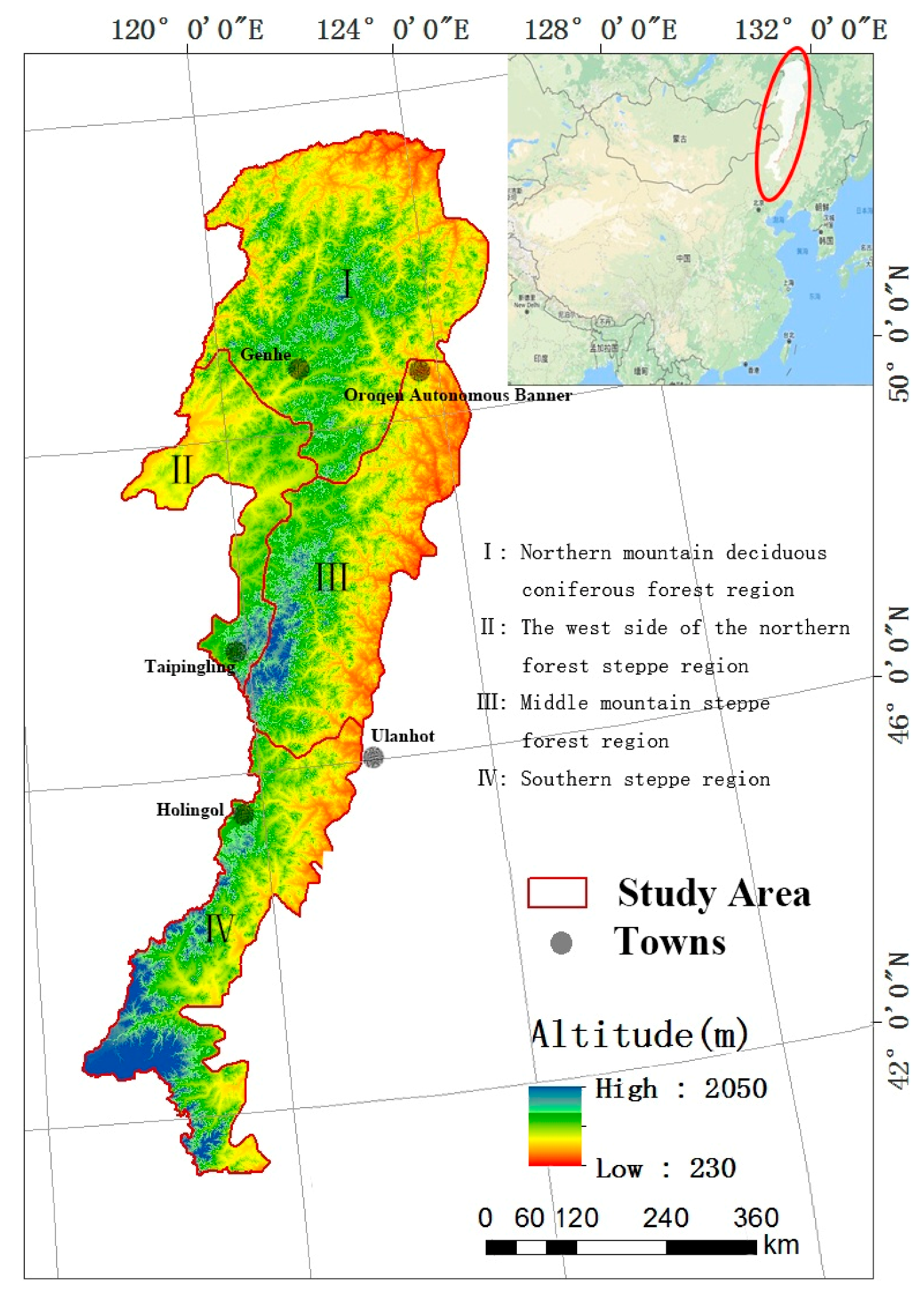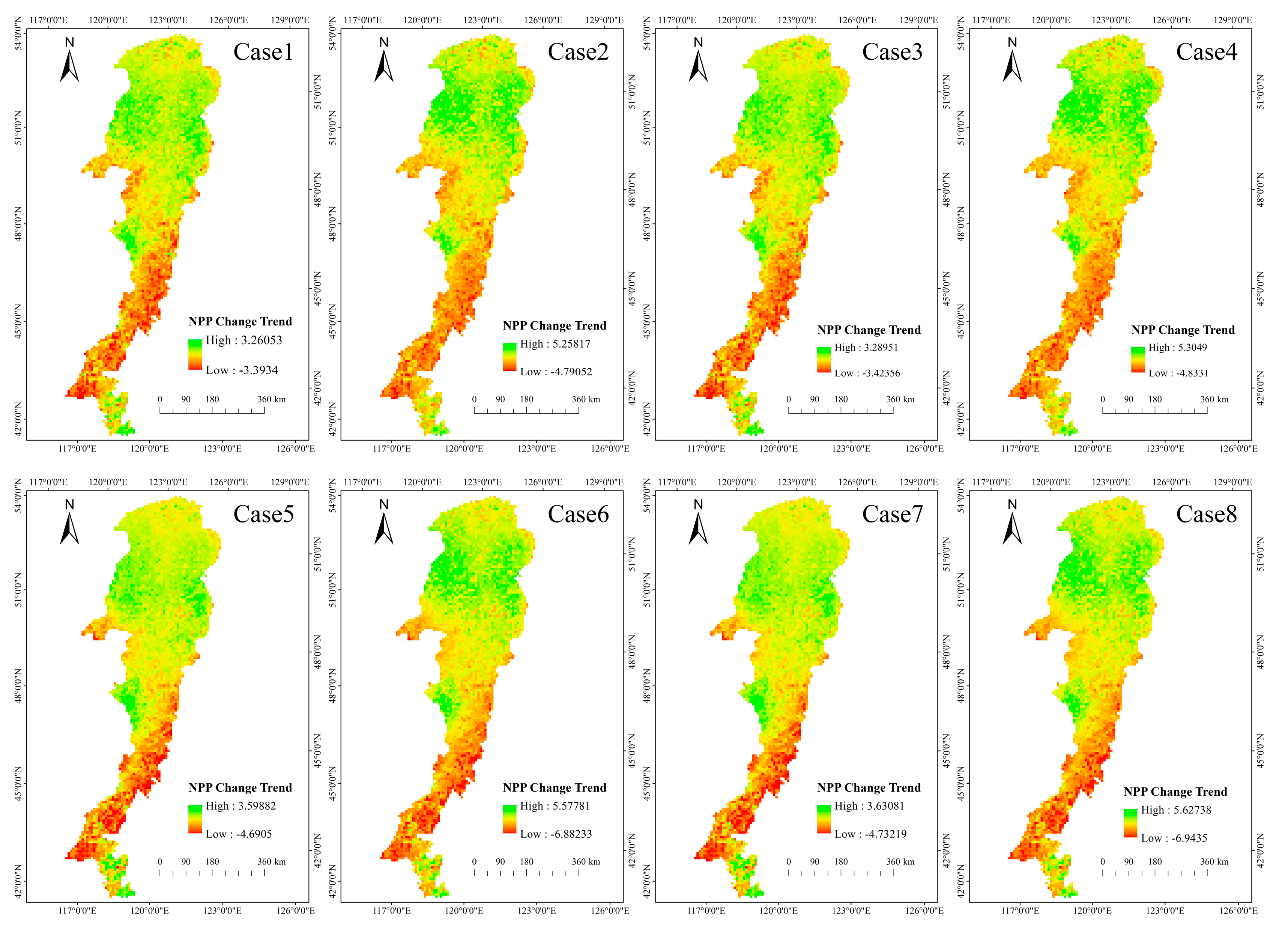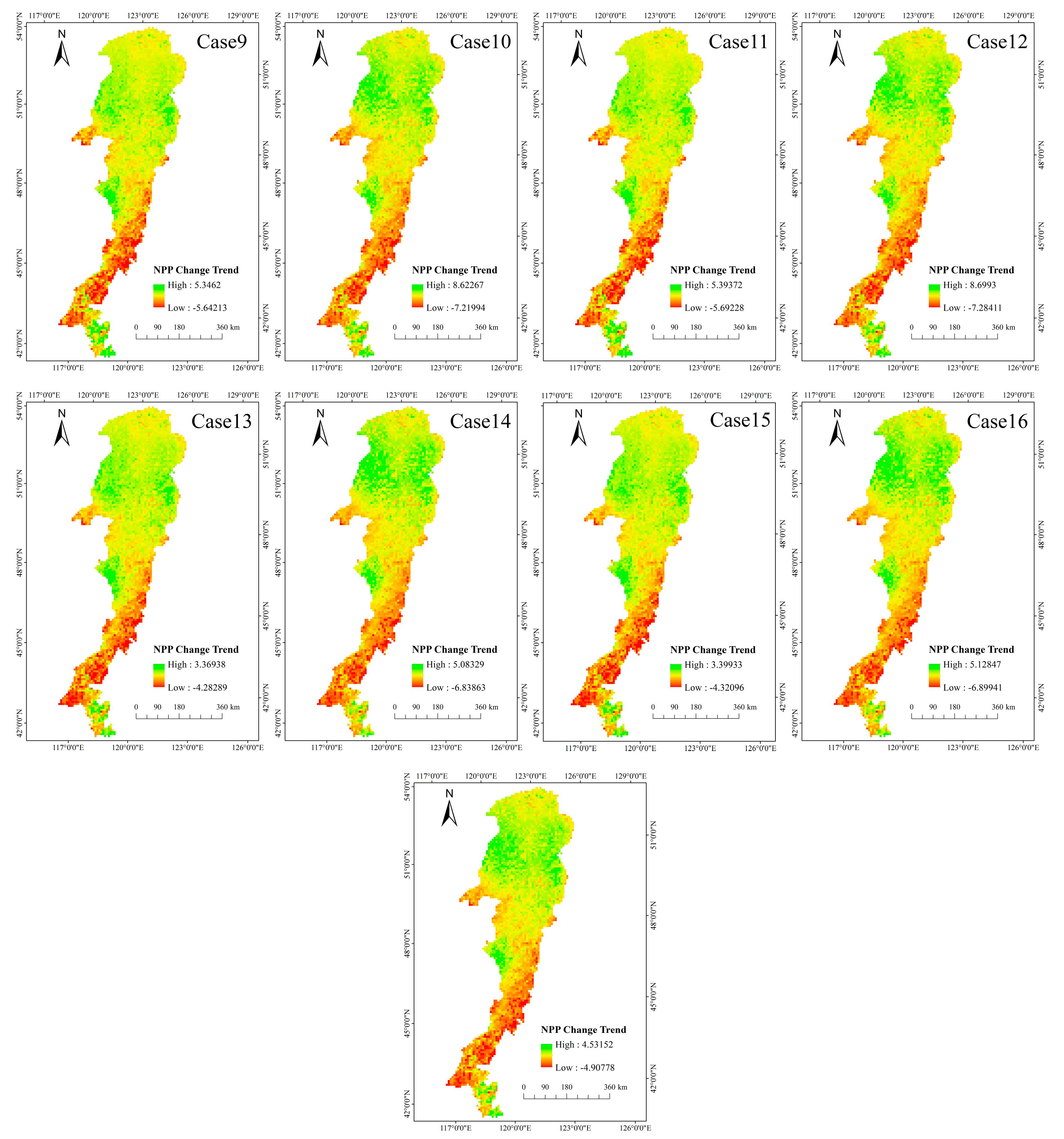Remotely Sensed Estimation of Net Primary Productivity (NPP) and Its Spatial and Temporal Variations in the Greater Khingan Mountain Region, China
Abstract
:1. Introduction
2. Materials and Methods
2.1. Study Area
2.2. Methodology
2.2.1. CASA Model
2.2.2. Statistical Analysis Method
2.2.3. Trend Analysis Method
2.3. Data
2.3.1. GIMMS Dataset
2.3.2. Meteorological Data
2.3.3. Vegetation Type Dataset
2.3.4. Field Data
3. NPP Estimation
3.1. General Framework
3.2. SOL Algorithm
3.3. FPAR Algorithm
3.4. Algorithm of Tε1, Tε2 and Wε
3.5. The Maximum Light Use Efficiency
3.6. Model Implementation
4. Results and Discussion
4.1. Precision Verification and Evaluation
4.1.1. Comparison with Field NPP
4.1.2. Comparison with Other Researchers Who Used the Same Model
4.1.3. Accuracy Evaluation Summary
4.2. Trend of NPP
4.3. Spatial Patterns of NPP Trends
5. Conclusions
Acknowledgments
Author Contributions
Conflicts of Interest
References
- Field, C.B.; Behrenfeld, M.J.; Randerson, J.T.; Falkowski, P. Primary production of the biosphere: Integrating terrestrial and oceanic components. Science 1998, 281, 237–240. [Google Scholar] [CrossRef] [PubMed]
- Ruimy, A.; Saugier, B.; Dedieu, G. Methodology for the estimation of terrestrial net primary production from remotely sensed data. J. Geophys. Res. Atmos. 1994, 99, 5263–5283. [Google Scholar] [CrossRef]
- Nemani, R.R.; Keeling, C.D.; Hashimoto, H.; Jolly, W.M.; Piper, S.C.; Tucker, C.J.; Myneni, R.B.; Running, S.W. Climate-driven increases in global terrestrial net primary production from 1982 to 1999. Science 2003, 300, 1560–1563. [Google Scholar] [CrossRef] [PubMed]
- Peng, S.; Guo, Z.; Wang, B. Use of GIS and RS to estimate the light utilization efficiency of the vegetation in Guangdong, China. Acta Ecol. Sin. 2000, 20, 903–909. [Google Scholar]
- Ricotta, C.; Avena, G.; Palma, A.D. Mapping and monitoring net primary productivity with AVHRR NDVI time-series: statistical equivalence of cumulative vegetation indices. Isprs. J. Photogramm. Remote Sens. 1994, 54, 325–331. [Google Scholar] [CrossRef]
- Field, C.B.; Randerson, J.T.; Malmström, C.M. Global net primary production: Combining ecology and remote sensing. Remote Sens. Environ. 1995, 51, 74–88. [Google Scholar] [CrossRef]
- Piao, S.L.; Fang, J.Y.; Guo, Q.H. Application of CASA model to the estimation of Chinese terrestrial net primary productivity. Acta Phytoecol. Sin. 2001, 25, 603–608. [Google Scholar]
- Potter, C.S.; Randerson, J.T.; Field, C.B.; Matson, P.A.; Vitousek, P.M.; Mooney, H.A.; Klooster, S.A. Terrestrial ecosystem production: A process model based on global satellite and surface data. Glob. Biogeochem. Cycles 1993, 7, 811–841. [Google Scholar] [CrossRef]
- Chen, L.J.; Liu, G.H.; Li, H.G. Estimating Net Primary Productivity of Terrestrial Vegetation in China Using Remote Sensing. J. Remote Sens. 2002, 6, 129–135. [Google Scholar]
- Fang, J.; Piao, S.; Field, C.B.; Pan, Y.; Guo, Q.; Zhou, L.; Peng, C.; Tao, S. Increasing net primary production in China from 1982 to 1999. Front. Ecol. Environ. 2003, 1, 293–297. [Google Scholar] [CrossRef]
- Running, S.W.; Thornton, P.E.; Nemani, R.; Glassy, J.M. Global Terrestrial Gross and Net Primary Productivity from the Earth Observing System. In Methods in Ecosystem Science; Springer: New York, NY, USA, 2000; pp. 44–57. [Google Scholar]
- Li, T.; Wang, Z. Estimation of Monthly Net Primary Productivity and Its Variation Characteristics in Shenzhen Based on CASA Model, GIS and RS. J. Basic Sci. Eng. 2012, 20, 126–135. [Google Scholar]
- Myneni, R.B.; Knyazikhin, Y.; Zhang, Y.; Tian, Y.; Wang, Y.; Lotsch, A.; Privette, J.L.; Morisette, J.T.; Running, S.W.; Nemani, R. MODIS Leafarea Index (LAI) and Fraction of Photosynthetically Activeradiation Absorbed by Vegetation (FPAR) Product (MOD15) Algorithm Theoretical Bas Is Document. Available online: https://modis.gsfc.nasa.gov/data/atbd/atbd_mod15.pdf (accessed on 1 May 2017).
- Zhu, W.; Pan, Y.; He, H.; Yu, D.; Hu, H. Simulation of Maximum Light Use Efficiency of Typical Vegetation in China. Chin. Sci. Bull. 2006, 51, 457–463. [Google Scholar] [CrossRef]
- Zhu, W. Estimation of Light Utilization Efficiency of Vegetation in China Based on GIS and RS. Geomat. Inf. Sci. Wuhan Univ. 2004, 29, 694–698. [Google Scholar]
- Zhang, N.; Yu, G.; Yu, Z.; Zhao, S. Analysis on factors affecting net primary productivity distribution in Changbai Mountain based on process model for landscape scale. Chin. J. Appl. Ecol. 2003, 14, 659. [Google Scholar]
- Zhang, J.; Gao, Z.; Gao, W.; Pan, X.; Zhao, S.; Shi, Q.; Lu, G. Landscape heterogeneity and net primary productivity (NPP) of mountain-oasis-desert ecosystems in western China. Proc. SPIE 2004, 5153. [Google Scholar] [CrossRef]
- Wang, Q.; Zhang, T.; Yi, G.; Chen, T.; Bie, X.; He, Y. Tempo-spatial variations and driving factors analysis of net primary productivity in the Hengduan mountain area from 2004 to 2014. Acta Ecol. Sin. 2017, 37, 3084–3095. [Google Scholar] [CrossRef]
- Stenzel, J.A. Towards Intra-Seasonal Estimation of Forest Net Primary Productivity: Evaluating Automated Dendrometers for High-Temporal Resolution Woody Growth Signals. Ph.D. Thesis, University of Idaho, Moscow, ID, USA, 2016. [Google Scholar]
- WU, S.; Pan, T.; Liu, Y.; Deng, H.; Jiao, K.; Lu, Q.; Feng, A.; Yue, X.; Yin, Y.; Zhao, D. Comprehensive climate change risk regionalization of China. Acta Geogr. Sin. 2017, 72. [Google Scholar] [CrossRef]
- Hao, C.; Zhao, T. Comparative Research on Regional Respond to Global Climate Change in China. Areal Res. Dev. 2011, 3, 56–61. [Google Scholar]
- Zheng, D. China’s Eco-Geographical Region Map; The Commercial Press: Beijing, China, 2008. [Google Scholar]
- Zhao, M.; Zhou, G.S. Estimation of biomass and net primary productivity in major planted forests in China based on forest inventory data. For. Ecol. Manag. 2005, 207, 295–313. [Google Scholar] [CrossRef]
- Zhou, G.; Wang, Y.; Jiang, Y.; Yang, Z. Estimating biomass and net primary production from forest inventory data: a case study of China’s Larix forests. For. Ecol. Manag. 2002, 169, 149–157. [Google Scholar] [CrossRef]
- Zhu, F. Research about the Net Primary Productivity of the Farmland in the Northeast of China Based on the CASA Model. Master’s Thesis, Northeast Normal University, Changchun, China, 2011. [Google Scholar]
- Zhu, W.; Long, Z.; Pan, Y. Estimating Net Primary Productivity of Terrestrial Vegetation Based on GIS and RS: A Case Study in Inner Mongolia, China. J. Remote Sens. 2005, 9, 300–307. [Google Scholar]
- Los, S.O.; Justice, C.O.; Tucker, C.J.; Sellers, P.J.; Collatz, G.J.; Dazlich, D.A.; Randall, D.A. A global 1° by 1° NDVI dataset for climate studies derived from GIMMS continental NDVI data. Int. J. Remote Sens. 1994, 15, 3493–3518. [Google Scholar] [CrossRef]
- Li, X. Inversion and Verification of FPAR Based on Remote Sensing Ground Test—A Case Study of Hulunbeier. Master’s Thesis, Inner Mongolia Normal University, Hohehot, China, 2015. [Google Scholar]
- Zhou, G.S.; Zhang, X.S. Study on Climate-vegetation Classification for Global Change in China. Acta Bot. Sin. 1996, 38, 8–17. [Google Scholar]
- Li, M.Z.; Wang, B.; Fan, W.Y.; Zhao, D. Simulation of forest net primary production and the effects of fire disturbance in Northeast China. Chin. J. Plant Ecol. 2015, 39, 322–332. [Google Scholar]
- Zhang, F.; Zhou, G. Spatial-Temporal Variations in Net Primary Productivity along Northeast China Transect (NECT) from 1982 to 1999. J. Plant Ecol. 2008, 32, 798–809. [Google Scholar]
- Chen, F.; Shen, Y.; Li, Q.; Guo, Y.; Xu, L. Spatio-temporal Variation Analysis of Ecological Systems NPP in China in Past 30 years. Sci. Geogr. Sin. 2011, 31, 1409–1414. [Google Scholar]




| Value | Vegetation | NDVImax | NDVImin | SRmax | SRmin |
|---|---|---|---|---|---|
| 2 | Deciduous Broad-Leaved Forest | 0.747 | 0.023 | 6.91 | 1.05 |
| 4 | Evergreen Coniferous Forest | 0.647 | 0.023 | 4.67 | 1.05 |
| 5 | Deciduous Coniferous Forest | 0.738 | 0.023 | 6.63 | 1.05 |
| 6 | Coniferous and Broad-Leaved Mixed Forest | 0.738 | 0.023 | 6.63 | 1.05 |
| 9 | Shrub | 0.636 | 0.023 | 4.49 | 1.05 |
| 10 | City and Water | 0.634 | 0.023 | 4.46 | 1.05 |
| 11 | Shrub | 0.636 | 0.023 | 4.49 | 1.05 |
| 12 | |||||
| 14 | Shrub | 0.636 | 0.023 | 4.49 | 1.05 |
| 15 | City and Water | 0.634 | 0.023 | 4.46 | 1.05 |
| 16 | Cultivable Land | 0.634 | 0.023 | 4.46 | 1.05 |
| 17 | |||||
| 18 | Cultivable Land | 0.634 | 0.023 | 4.46 | 1.05 |
| 19 | City and Water | 0.634 | 0.023 | 4.46 | 1.05 |
| 20 |
| Original Values | Vegetation | SRmax |
|---|---|---|
| 2 | Deciduous Broad-Leaved Forest | 6.17 |
| 4 | Evergreen Coniferous Forest | 5.43 |
| 5 | Deciduous Coniferous Forest | 5.43 |
| 6 | Coniferous and Broad-Leaved Mixed Forest | 6.17 |
| 9 | Bush and Shrub | 5.13 |
| 10 | Broad-Leaved Shrubs and Bare Land | 5.13 |
| 11 | Bush and Shrub | 5.13 |
| 12 | Grass Land | 5.13 |
| 13 | Grass Land | 5.13 |
| 14 | Broad-Leaved Shrubs and Bare Land | 5.13 |
| 15 | Broad-Leaved Shrubs and Bare Land | 5.13 |
| 16 | Cultivable Land | 5.13 |
| 17 | Cultivable Land | 5.13 |
| 18 | Cultivable Land | 5.13 |
| 19 | Broad-Leaved Shrubs and Bare Land | 5.13 |
| 20 | Broad-Leaved Shrubs and Bare Land | 5.13 |
| Original Value | Vegetation Type by Zhu | εmax by Zhu | Vegetation Type by Running | εmax by Running |
|---|---|---|---|---|
| 2 | Deciduous Broad-Leaved Forest | 0.692 | Deciduous Broad-Leaved Forest | 1.044 |
| 4 | Evergreen Coniferous Forest | 0.389 | Evergreen Coniferous Forest | 0.389 |
| 5 | Deciduous Coniferous Forest | 0.485 | Deciduous Coniferous Forest | 1.103 |
| 6 | Coniferous and Broad-Leaved Mixed Forest | 0.475 | Coniferous and Broad-Leaved Mixed Forest | 1.116 |
| 9 | Shrub | 0.429 | Deciduous Shrub and Savanna | 0.768 |
| 10 | City and Water | 0.542 | City and Water | 0.389 |
| 11 | Shrub | 0.429 | Dense Shrub | 0.888 |
| 12 | Shrub | 0.429 | Deciduous Shrub and Savanna | 0.768 |
| 13 | Grass Land | 0.542 | Grass Land | 0.608 |
| 14 | Shrub | 0.429 | Sparse Shrub | 0.774 |
| 15 | City and Water | 0.542 | City and Water | 0.389 |
| 16 | Cultivable Land | 0.542 | Cultivable Land | 0.604 |
| 17 | Cultivable Land | 0.542 | Cultivable Land | 0.604 |
| 18 | Cultivable Land | 0.542 | Cultivable Land | 0.604 |
| 19 | City and Water | 0.542 | City and Water | 0.389 |
| 20 | City and Water | 0.542 | City and Water | 0.389 |
| Case Number | FPAR | FPARmax | Tε2 | εmax |
|---|---|---|---|---|
| 1 | Li | 0.916 | Potter | Zhu |
| 2 | Li | 0.916 | Potter | Running |
| 3 | Li | 0.916 | Li | Zhu |
| 4 | Li | 0.916 | Li | Running |
| 5 | Zhu | 0.95 | Potter | Zhu |
| 6 | Zhu | 0.95 | Potter | Running |
| 7 | Zhu | 0.95 | Li | Zhu |
| 8 | Zhu | 0.95 | Li | Running |
| 9 | Potter | 0.95 | Potter | Zhu |
| 10 | Potter | 0.95 | Potter | Running |
| 11 | Potter | 0.95 | Li | Zhu |
| 12 | Potter | 0.95 | Li | Running |
| 13 | Zhu | 0.90255 | Potter | Zhu |
| 14 | Zhu | 0.90255 | Potter | Running |
| 15 | Zhu | 0.90255 | Li | Zhu |
| 16 | Zhu | 0.90255 | Li | Running |
| R2 | Case Number | FPAR | FPARmax | Tε2 | εmax |
|---|---|---|---|---|---|
| 0.8062 | 2 | Li | 0.916 | Potter | Running |
| 4 | Li | 0.916 | Li | Running | |
| 0.7999 | 14 | Zhu | 0.90255 | Potter | Running |
| 16 | Zhu | 0.90255 | Li | Running | |
| 0.7872 | 6 | Zhu | 0.95 | Potter | Running |
| 8 | Zhu | 0.95 | Li | Running | |
| 0.7871 | 10 | Potter | 0.95 | Potter | Running |
| 12 | Potter | 0.95 | Li | Running | |
| 0.1470 | 1 | Li | 0.916 | Potter | Zhu |
| 3 | Li | 0.916 | Li | Zhu | |
| 0.0942 | 9 | Potter | 0.95 | Potter | Zhu |
| 11 | Potter | 0.95 | Li | Zhu | |
| 0.0814 | 13 | Zhu | 0.90255 | Potter | Zhu |
| 15 | Zhu | 0.90255 | Li | Zhu | |
| 0.0697 | 5 | Zhu | 0.95 | Potter | Zhu |
| 7 | Zhu | 0.95 | Li | Zhu |
| Researcher | Study Area | Time Series | Annual Average NPP (g C/m2·a) |
|---|---|---|---|
| This Paper | Greater Khingan Mountains | 1982–2013 | NPP1: 539.874 NPP2: 869.745 NPP3: 544.672 NPP4: 877.475 NPP5: 610.688 NPP6: 970.542 NPP7: 616.116 NPP8: 979.168 NPP9: 595.696 NPP10: 952.177 NPP11: 600.990 NPP12: 960.640 NPP13: 586.066 NPP14: 930.675 NPP15: 591.274 NPP16: 938.947 Mean: 760.019 |
| Dehua Mao [30] | Northeast China | 1982–2010 | 600–800 |
| Feng Zhang [31] | Northeast China Transect | 1982–1999 | 58–811 |
| Fujun Chen [32] | Terrestrial Ecosystem of China (Forests in Northeast China) | 1981–2008 | Over 600 |
| Field Data | Greater Khingan Mountains | 2015 | 915 |
| Trend | Level | Area (km²) | Area Change Rate (%) |
|---|---|---|---|
| <0 | Decreased | 42,112 | 14.77324 |
| 0–2 | Essentially Unchanged | 216,512 | 75.9542 |
| >2 | Increased | 26,432 | 9.272564 |
© 2017 by the authors. Licensee MDPI, Basel, Switzerland. This article is an open access article distributed under the terms and conditions of the Creative Commons Attribution (CC BY) license (http://creativecommons.org/licenses/by/4.0/).
Share and Cite
Zhu, Q.; Zhao, J.; Zhu, Z.; Zhang, H.; Zhang, Z.; Guo, X.; Bi, Y.; Sun, L. Remotely Sensed Estimation of Net Primary Productivity (NPP) and Its Spatial and Temporal Variations in the Greater Khingan Mountain Region, China. Sustainability 2017, 9, 1213. https://doi.org/10.3390/su9071213
Zhu Q, Zhao J, Zhu Z, Zhang H, Zhang Z, Guo X, Bi Y, Sun L. Remotely Sensed Estimation of Net Primary Productivity (NPP) and Its Spatial and Temporal Variations in the Greater Khingan Mountain Region, China. Sustainability. 2017; 9(7):1213. https://doi.org/10.3390/su9071213
Chicago/Turabian StyleZhu, Qiang, Jianjun Zhao, Zhenhua Zhu, Hongyan Zhang, Zhengxiang Zhang, Xiaoyi Guo, Yunzhi Bi, and Li Sun. 2017. "Remotely Sensed Estimation of Net Primary Productivity (NPP) and Its Spatial and Temporal Variations in the Greater Khingan Mountain Region, China" Sustainability 9, no. 7: 1213. https://doi.org/10.3390/su9071213





